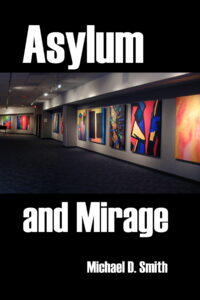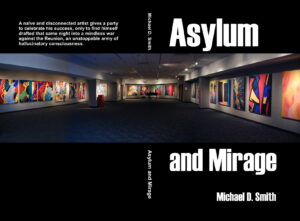Asylum and Mirage: The Publication
 Artist Dave Raavenscorr tries to seduce what he considers a neurotic college girl only to discover she’s Dr. Marina Nunn, chair of the Lake University Music Department and a refugee from the Reunion brainwashing disaster hundreds of miles south. Paranoid she’s contaminated him, Dave shows up late to a party his best friend is throwing in his honor.
Artist Dave Raavenscorr tries to seduce what he considers a neurotic college girl only to discover she’s Dr. Marina Nunn, chair of the Lake University Music Department and a refugee from the Reunion brainwashing disaster hundreds of miles south. Paranoid she’s contaminated him, Dave shows up late to a party his best friend is throwing in his honor.
Art maven Reva McKee has invited a hundred fifty guests to Dave’s quirky art warehouse, but they’ve really come to seek succor from the charismatic Marshall Singletree, the Great Migrator who escaped two Reunion catastrophes in the south. Yet no one can admit their placid college town lies in the path of mind-breaking Reunion armies.
Where to Find It
Amazon trade paperback and eBook
Barnes & Noble trade paperback and eBook
Lulu.com mass-market paperback
Draft2Digital eBook (links to many distributors)
Asylum’s Ancient History
Maybe nobody wants to hear how much struggle goes into a novel. I’d already given an overview of the book’s history in its first post, but this expanded view may give a feel for all the wrong turns and obstacles that went into this thing over quite a long time. In retrospect it can all seem silly. You may wonder: Why doesn’t the author just write the final version first?
Though some Asylum and Mirage ideas go back several decades, I now see them as just underpinnings to a new story, with new characters and fresh perspective. In contrast with two other novels, Akard Drearstone and Sortmind, which got major reboots from far earlier versions but which were essentially the same story at the end, I consider the final Asylum and Mirage to be a new novel, my eighteenth. It began with:
“33,” 1985
so titled because it was thirty-three pages of disconnected character and plot musings, including one scene positing the final novel’s nightmare Reunion Topology warehouse district. “33” was originally intended as a novel, but within a month I’d scrapped that concept and considered those thirty-three pages a decent warm-up for the first draft of
Parts I and II, 1985,
an extremely rough-draft novel about brainwashing and evil, featuring naïve artist Dave sent off to war. I considered Parts I and II a failure but lifted a chapter for the 1986 rough draft of
Jack Commer, Commander, USSF,
where the stolen material became the basis for the Alpha Centaurian Grid and the fascist Head figuring in all subsequent Commer novels. In appropriating that chapter, I felt I’d effectively killed off Parts I and II, and yet
Notice and Dream Topology, 1992,
appeared on the scene to demand a rewrite of Parts I and II. This second draft was vastly improved and had an uncanny Twilight Zone-ish feel, but I left it unfinished, completing just Part I, Dave’s party in celebration of his artistic success, along with one scene of spies uncovering each other in a shell hole. During this version I got fascinated with playwriting and so started all over again, mashing NADT Part I and its notes for Part II into
Linstar, 1992,
a play that was the worst writing disaster I’ve ever concocted. In disgust I let this whole Dave/warehouse/war universe slide as I wrote other novels, including my flagship The Soul Institute; then years later, hoping to craft a masterpiece literary novel, I hit a wall with
Failed Notes, 2002,
an attempt to sort hundreds of note cards of ideas into fiction before realizing it would merely be a dull repetition of TSI; nevertheless, I hoped something would come of these notes, and thus the first concept arose of
Perpetual Starlit Night as a novel, 2002-2005,
an attempt to create a science fiction novel from the failed notes. But when I finally saw there was really just a good short story premise there, I abandoned the novel idea and wrote PSN as a forty-page story (2007, later published in Twisted Tails VII, Double Dragon Publishing, 2013). New energy for writing short stories then came up with
“Starvation Levels of the Infinite,” 2008,
a decent if uninspiring revision of “33,” intended for publication, though I never submitted it. Some fun Jack Commer novels mercifully came along to cut off this obsession with older writing, but meanwhile I was assembling
New Novel Notes, 2015 on,
even grave-digging some of the old 2002 notes, coming up with a vague, unwritable plot involving reincarnation. But just like the older notes, without a central compelling urge to write an actual story, the idea-rich NNN ultimately proved to be a waste of energy. Except that I felt the surreal inexplicability of the unfinished Notice and Dream Topology could be an ideal vehicle for exploring some of the character archetypes NNN had dredged up. Thus
Nine Archetypes, 2016,
sought to keep NNN in play by pulling out character studies of nine female archetypes from rough draft versions of all my novels beginning with The University of Mars (1984-2009, unpublished and rightly so). Nine Archetypes generated 124 semi-interesting pages, but these scenarios turned out to be repetitive and unusable; in no way were they real fiction. Yet the NNN juggernaut plowed on, and one of its saving ideas was a
Possible angle on a Sortmind II, 2018,
four pages of (desperate?) notes for a Sortmind sequel incorporating my 1981 rough draft novel Zarreich as well as anything worthwhile from NNN. I quickly discarded this possibility, but the ongoing pressure to come up with a new novel with NNN overtones resulted in a flirtation with turning the already-published short story
“Perpetual Starlit Night”
back into a 2020 novel, exploring a long narrative different from the one I’d envisioned 2002-05. I dropped this plan in favor of keeping PSN as a story and I later published it in The Damage Patrol Quartet. But ongoing NNN/NADT novel pressure came up with the 2021 concept of adding my old novella
The Psychobeauty, 1983,
into the mix. It seemed to be a great idea at the time; I could simply finish Notice and Dream Topology by combining it with The Psychobeauty, in which ninety-seven percent of the earth’s population inexplicably commits suicide, ending civilization and leaving scattered refugees struggling to resist their own suicidal urges. But The Psychobeauty proved to be a sinkhole threatening to swallow NADT and change its tone and meaning. By now NADT dominated the new novel ideas, and, to help new character archetypes unfold
Interview Series 1, 2021,
interviewed five male and five female archetypes through 121 pages. The wonderful new characters volunteered plot and people developments I couldn’t have come up with alone, and in high energy we all churned out
Caspra Coronae, 2021-2022,
the first draft of the novel in 425 pages and 121,780 words. I had some regret at CC being close to earlier Parts I and II work, but this was a new novel in so many ways, and it was a valid experiment, even a risky one across several decades. Did I really manage to express any of that NNN and Archetype stuff? Or was this just an interesting rewrite of an old novel? Meanwhile
Interviews Series 2, 2022,
let the Draft 1 characters muse on their own desired endings, and in a series of complex negotiations we combined several main characters and changed the title of the novel to
Asylum and Mirage, 2022-2023,
which provided badly needed focus and finally pulled the novel together into a decidedly new work. “Asylum” connotes a somewhat fragile sanctuary, and “Mirage” is a dangerously wrong perception despite its undertone of loveliness. Together characters and I crafted a new ending by eliminating the old concept of “Part II” altogether and just continuing the narrative after Dave gets his draft notice. His untrained army company remains holed up in his art warehouse over the next anxiety-laced month as the cruel, brainless armies of the Reunion steadily advance.
copyright 2023 by Michael D. Smith
Caspra Coronae Draft One Blast-Off, July 3, 2021
Interview with the Burlcron/Mercer/Singletree, August 3, 2021
Walter’s Farewell Soliloquy–to Himself and to Draft 1 Caspra Coronae, February 26, 2022
Progress: Asylum and Mirage and the Title Change, April 25, 2022
Asylum and Mirage: The Draft 2 Milestone, June 17, 2022
Asylum and Mirage: Current Conditions, October 19, 2022
Asylum and Mirage and the Long Compositions, February 1, 2023


Comments
Asylum and Mirage: The Publication — No Comments
HTML tags allowed in your comment: <a href="" title=""> <abbr title=""> <acronym title=""> <b> <blockquote cite=""> <cite> <code> <del datetime=""> <em> <i> <q cite=""> <s> <strike> <strong>